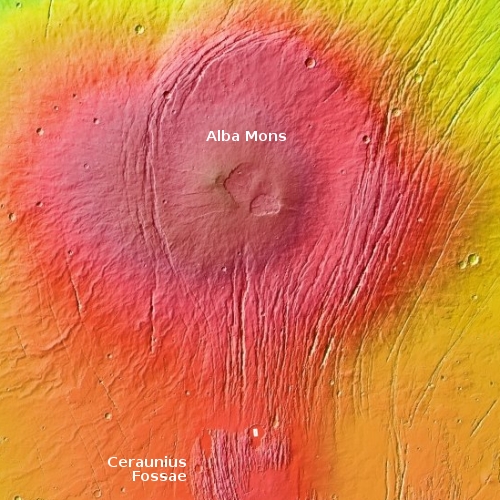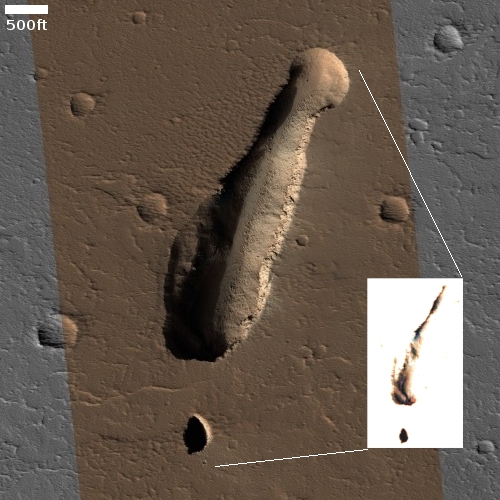Collapse pits on Mars
Cool image time! The photo to the right, cropped to post here, was taken on May 21, 2022 and was today’s picture of the day from the high resolution camera on Mars Reconnaissance Orbiter (MRO). Dubbed “An Elongated Collapse Pit” by the science team, their caption explains:
This observation can help to tell whether or not there is a subterranean connection to this pit. As an added bonus, the much smaller depression to its south also appears to be another collapse pit.
This image had already been in my queue for a future cool image post, but since the scientists have posted it, it is time that I did as well.
In the inset I have brightened the image drastically to try to illuminate the darkest spots in both pits. The elongated pit appears to slope downward towards a hole in the southeast corner, while the interior of the second pit to the south remains completely dark. Both appear to suggest a void below that both reach.
The wider context image and overview map below shows that there is further evidence of more voids in this region of Mars, dubbed Ceraunius Fossae, because of its many north-south parallel fissures.

Original images for this mosaic can be found here, here, and here.

The first image to the right is a mosaic made from three MRO context camera images. The number one notes the location of the elongated pit above. The number two marks the location of a previous cool image from October 2019, also showing similar aligned collapse features.
The overview map below shows the location of today’s photo by the white box near the bottom center, with the earlier collapse feature #2 to its southwest. Both numbered pits are located in a large flat circular feature that suggest two or more overlapping impact craters that appear to hit the surrounding north-south fissures after they had formed. The impact melted those fissures, and when that melted material hardened it did so inside the craters, forming a frozen lake of smooth lava about 30 by 45 miles in size.
These north-south fissures are thought to be what geologists call grabens, cracks created when two sections of ground are either pulled apart or shifted in oppose directions. Because this location is at 30 degrees latitude at a relatively high elevation, it is also possible that glacial underground ice is located here.
When you put underground ice in a volcanic region, you can often get melted underground ice, which when it melts or sublimates can cause erosion that leaves voids. The surface then can collapse, producing the pits. If you look closely at the mosaic, you can see what appears to be a number of other similar collapse pits, also associated with mostly buried north-south fissures, most of which have not yet been observed by MRO’s high resolution camera.
Buried ice is not the only explanation for these collapse pits. The nature of lava on Mars, running much faster than on Earth, could also be a factor, though our understanding of this alien geological process is as yet very incomplete.
On Christmas Eve 1968 three Americans became the first humans to visit another world. What they did to celebrate was unexpected and profound, and will be remembered throughout all human history. Genesis: the Story of Apollo 8, Robert Zimmerman's classic history of humanity's first journey to another world, tells that story, and it is now available as both an ebook and an audiobook, both with a foreword by Valerie Anders and a new introduction by Robert Zimmerman.
The print edition can be purchased at Amazon or from any other book seller. If you want an autographed copy the price is $60 for the hardback and $45 for the paperback, plus $8 shipping for each. Go here for purchasing details. The ebook is available everywhere for $5.99 (before discount) at amazon, or direct from my ebook publisher, ebookit. If you buy it from ebookit you don't support the big tech companies and the author gets a bigger cut much sooner.
The audiobook is also available at all these vendors, and is also free with a 30-day trial membership to Audible.
"Not simply about one mission, [Genesis] is also the history of America's quest for the moon... Zimmerman has done a masterful job of tying disparate events together into a solid account of one of America's greatest human triumphs."--San Antonio Express-News
Cool image time! The photo to the right, cropped to post here, was taken on May 21, 2022 and was today’s picture of the day from the high resolution camera on Mars Reconnaissance Orbiter (MRO). Dubbed “An Elongated Collapse Pit” by the science team, their caption explains:
This observation can help to tell whether or not there is a subterranean connection to this pit. As an added bonus, the much smaller depression to its south also appears to be another collapse pit.
This image had already been in my queue for a future cool image post, but since the scientists have posted it, it is time that I did as well.
In the inset I have brightened the image drastically to try to illuminate the darkest spots in both pits. The elongated pit appears to slope downward towards a hole in the southeast corner, while the interior of the second pit to the south remains completely dark. Both appear to suggest a void below that both reach.
The wider context image and overview map below shows that there is further evidence of more voids in this region of Mars, dubbed Ceraunius Fossae, because of its many north-south parallel fissures.

Original images for this mosaic can be found here, here, and here.

The first image to the right is a mosaic made from three MRO context camera images. The number one notes the location of the elongated pit above. The number two marks the location of a previous cool image from October 2019, also showing similar aligned collapse features.
The overview map below shows the location of today’s photo by the white box near the bottom center, with the earlier collapse feature #2 to its southwest. Both numbered pits are located in a large flat circular feature that suggest two or more overlapping impact craters that appear to hit the surrounding north-south fissures after they had formed. The impact melted those fissures, and when that melted material hardened it did so inside the craters, forming a frozen lake of smooth lava about 30 by 45 miles in size.
These north-south fissures are thought to be what geologists call grabens, cracks created when two sections of ground are either pulled apart or shifted in oppose directions. Because this location is at 30 degrees latitude at a relatively high elevation, it is also possible that glacial underground ice is located here.
When you put underground ice in a volcanic region, you can often get melted underground ice, which when it melts or sublimates can cause erosion that leaves voids. The surface then can collapse, producing the pits. If you look closely at the mosaic, you can see what appears to be a number of other similar collapse pits, also associated with mostly buried north-south fissures, most of which have not yet been observed by MRO’s high resolution camera.
Buried ice is not the only explanation for these collapse pits. The nature of lava on Mars, running much faster than on Earth, could also be a factor, though our understanding of this alien geological process is as yet very incomplete.
On Christmas Eve 1968 three Americans became the first humans to visit another world. What they did to celebrate was unexpected and profound, and will be remembered throughout all human history. Genesis: the Story of Apollo 8, Robert Zimmerman's classic history of humanity's first journey to another world, tells that story, and it is now available as both an ebook and an audiobook, both with a foreword by Valerie Anders and a new introduction by Robert Zimmerman.
The print edition can be purchased at Amazon or from any other book seller. If you want an autographed copy the price is $60 for the hardback and $45 for the paperback, plus $8 shipping for each. Go here for purchasing details. The ebook is available everywhere for $5.99 (before discount) at amazon, or direct from my ebook publisher, ebookit. If you buy it from ebookit you don't support the big tech companies and the author gets a bigger cut much sooner.
The audiobook is also available at all these vendors, and is also free with a 30-day trial membership to Audible.
"Not simply about one mission, [Genesis] is also the history of America's quest for the moon... Zimmerman has done a masterful job of tying disparate events together into a solid account of one of America's greatest human triumphs."--San Antonio Express-News



There are the things that need investigating with a chopper.
Pre-made flame trench!
Ha !
Another Spelunkers dream ?